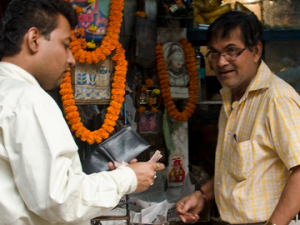
India might be lagging behind China, Russia, Brazil and many mature markets when it comes to cashless payments, but a surge in enthusiasm means that this is set to change.
The digital payments market has grown by 40% this year alone, and is expected to hit $20 billion by next month. Commentators in the country’s largest cities highlight a proliferation of money transfer, payment and account services offered to unbanked Indians in the tiniest of shops and vendor outlets (called “Kirana banking”), and of cheap mobile phones combined with upcoming online payment systems to become micro-ATMs and Point of Sale devices.
Just 260 million of the country’s 1.3 billion citizens currently have a bank account, and only 350 million debit cards and 19 million credit cards have been issued in the country. Given the nascent, but rising, interest in digital and mobile-based payments, this presents tantalising opportunities for innovators willing to circumvent traditional routes altogether and provide tailored alternatives to the 95% of transactions that are currently made by cash or cheque.
The government is also throwing itself behind the shift. Extensive regulations have kept fraud and security breach rates low and boosted user confidence, while the launch of the Digital India program, the creation of the Bharat bill payments system to combat fragmented payments and the development of a new “people’s wealth program” to promote financial inclusiveness continue to propel the industry forward.
“India is at a ‘digital payments sweet spot’ because of a series of initiatives and enablers both at the government level and in the competitive private space,” said Capgemini’s Christophe Vergne, who heads up the consulting firm’s Global Cards and Payments Centre of Excellence.
Younger generations are likely to provide the most receptive audience for payments entrepreneurs. Over 70% of India’s internet users are under 35, with 60% of these internet users doing so through their phones. In a relatively short space of time, smartphone ownership has exploded in the country, and the government has said that it wants every Indian to have one by 2019.
There’s still a long way to go before ubiquitous ownership, but it’s certainly not impossible. 120m Indians have a smartphone so far – not far shy of half the number that have bank accounts, which speaks volumes about how well the idea has caught on compared to long-established finance options.
What’s more, those that buy smartphones are also showing market willingness to use them for payments, with Avendus reporting a “surge” in the number of people storing card details in mobile apps to speed up the process.
While other countries around the world are starting to talk about payments technology fatigue, India is showing itself to be a land of opportunity for entrepreneurs that are not interested in fighting for market share with embedded competitors, but are instead coming up with something genuinely new.







